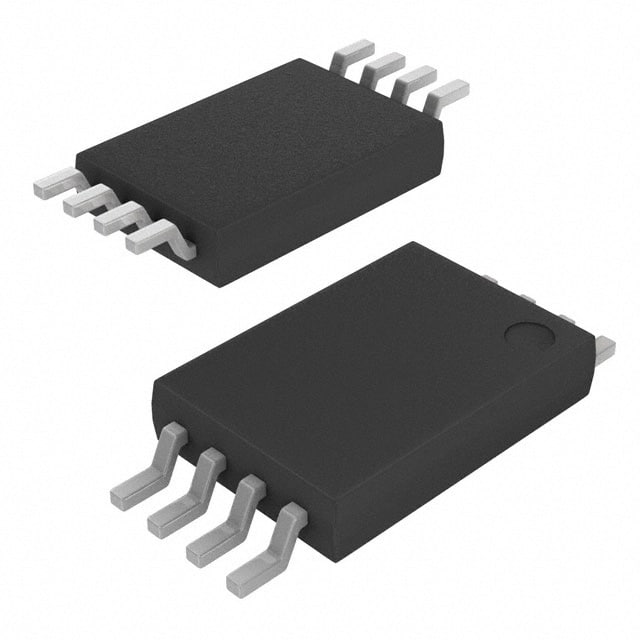Viz Specifikace pro podrobnosti o produktu.

S-24C128CI-T8T1U3
Basic Information Overview
- Category: Integrated Circuit (IC)
- Use: Non-volatile Memory
- Characteristics: Serial EEPROM, 128 Kilobits (16K x 8-bit), I2C Interface
- Package: TSSOP-8
- Essence: Data storage and retrieval
- Packaging/Quantity: Tape & Reel, 3000 units per reel
Specifications
- Memory Size: 128 Kilobits (16K x 8-bit)
- Interface: I2C (Inter-Integrated Circuit)
- Operating Voltage: 1.7V to 5.5V
- Operating Temperature Range: -40°C to +85°C
- Write Cycle Time: 5 ms (maximum)
- Data Retention: 200 years (minimum)
Detailed Pin Configuration
The S-24C128CI-T8T1U3 IC has a total of 8 pins arranged as follows:
```
| | | 1 8 | | | | 2 7| | | | 3 6| | | | 4 5 | |___________| ```
Pin Description: 1. VCC: Power supply voltage 2. SDA: Serial data input/output pin 3. SCL: Serial clock input pin 4. WP: Write protect pin 5. NC: No connection 6. GND: Ground 7. NC: No connection 8. NC: No connection
Functional Features
- Non-volatile memory: Retains data even when power is disconnected
- Serial EEPROM: Uses I2C interface for communication
- High storage capacity: 128 Kilobits (16K x 8-bit)
- Low power consumption: Operates at a wide voltage range (1.7V to 5.5V)
- Fast write cycle time: 5 ms maximum
- Long data retention: Minimum of 200 years
Advantages and Disadvantages
Advantages: - Compact size and lightweight - Easy integration into various electronic devices - High data reliability and integrity - Low power consumption - Wide operating voltage range
Disadvantages: - Limited storage capacity compared to other memory technologies - Slower write cycle time compared to some alternatives
Working Principles
The S-24C128CI-T8T1U3 is based on the I2C protocol, which allows for serial communication between the IC and the microcontroller or other devices. It utilizes EEPROM (Electrically Erasable Programmable Read-Only Memory) technology, which enables non-volatile data storage. The IC can be accessed by sending specific commands through the SDA and SCL pins, allowing data to be read from or written to the memory cells.
Detailed Application Field Plans
The S-24C128CI-T8T1U3 IC finds applications in various fields, including but not limited to: - Consumer electronics: Used in smart TVs, set-top boxes, and audio systems for storing configuration settings and user preferences. - Automotive: Employed in automotive control units for storing calibration data, fault codes, and vehicle-specific settings. - Industrial automation: Utilized in programmable logic controllers (PLCs), sensors, and data loggers for storing process parameters and historical data. - Medical devices: Integrated into medical equipment for storing patient data, device configurations, and firmware updates. - Internet of Things (IoT): Incorporated into IoT devices for storing sensor data, device identifiers, and network settings.
Detailed and Complete Alternative Models
- S-24C256CI-T8T1U3: 256 Kilobits (32K x 8-bit) serial EEPROM with I2C interface.
- S-24C64CI-T8T1U3: 64 Kilobits (8K x 8-bit) serial EEPROM with I2C interface.
- S-24C02CI-T8T1U3: 2 Kilobits (256 x 8-bit) serial EEPROM with I2C interface.
These alternative models offer different memory capacities to suit specific application requirements while maintaining compatibility with the I2C interface.
Word count: 498 words
Seznam 10 běžných otázek a odpovědí souvisejících s aplikací S-24C128CI-T8T1U3 v technických řešeních
Sure! Here are 10 common questions and answers related to the application of S-24C128CI-T8T1U3 in technical solutions:
Q1: What is S-24C128CI-T8T1U3? A1: S-24C128CI-T8T1U3 is a specific model of EEPROM (Electrically Erasable Programmable Read-Only Memory) chip that has a capacity of 128 kilobits.
Q2: What are the typical applications of S-24C128CI-T8T1U3? A2: S-24C128CI-T8T1U3 is commonly used in various technical solutions such as data storage, configuration memory, firmware storage, and parameter storage in electronic devices.
Q3: How does S-24C128CI-T8T1U3 connect to a microcontroller or other devices? A3: S-24C128CI-T8T1U3 uses an I2C (Inter-Integrated Circuit) interface to communicate with microcontrollers or other devices. It requires two lines - SDA (Serial Data) and SCL (Serial Clock).
Q4: What is the operating voltage range for S-24C128CI-T8T1U3? A4: The operating voltage range for S-24C128CI-T8T1U3 is typically between 1.7V and 5.5V.
Q5: Can S-24C128CI-T8T1U3 be used in automotive applications? A5: Yes, S-24C128CI-T8T1U3 is suitable for automotive applications as it can withstand the required temperature ranges and has high reliability.
Q6: Does S-24C128CI-T8T1U3 support write protection? A6: Yes, S-24C128CI-T8T1U3 supports software write protection by using specific commands to enable or disable write access to the memory.
Q7: What is the maximum data transfer rate of S-24C128CI-T8T1U3? A7: The maximum data transfer rate of S-24C128CI-T8T1U3 is typically 400 kilobits per second (Kbps).
Q8: Can S-24C128CI-T8T1U3 retain data during power loss? A8: Yes, S-24C128CI-T8T1U3 has built-in EEPROM technology that allows it to retain data even when power is lost.
Q9: Is S-24C128CI-T8T1U3 compatible with other I2C devices? A9: Yes, S-24C128CI-T8T1U3 is compatible with other I2C devices as long as they operate within the same voltage range and follow the I2C communication protocol.
Q10: Are there any limitations to the number of write cycles for S-24C128CI-T8T1U3? A10: Yes, S-24C128CI-T8T1U3 has a limited endurance for write cycles. It can typically handle around 1 million write cycles before the memory cells start to degrade.

